Contact Information
David M. Sabet
Business Owner
New Era Remodeling & Repairs, LLC
2305 Kildane Way, SE
Olympia, WA 98501
Office Tel: 360-706-9097
Mobile Tel: 360-706-9097
Normal Business Hours:
Between 10 am - 7:00 pm
Operating 6 days a week! Mon-Sat
Contractor License: NEWERER818OP
24 Hour Emergency:
Call 360-706-9097
Email: ServiceNow@NewEraRemodeling.com
Website:www.NewEraRemodeling.com
Termite and Pest Damage Repairs
We, at New Era Remodeling & Repairs, LLC are a licensed General Contractor in the State of Washington, Registration #: NEWERER818OP. We are well experienced in inspecting, detecting, and repairing areas damaged by termites, carpenter ants, mice, squirrels, and other pests at residential locations. We are located in Olympia, Washington, and serve the nearby cities. Here is the list of pest damaged related services that we can offer you:
* Ant Control/Fire Ant Control
* Cockroach Pest Control
* Flea Control
* Home Pest Control
* Mice Control/Rat Control
* Outdoor and Indoor Pest Control
* Pest Control Services
* Roach and Insects Control
* Termite and Pest Control
* Termite Damage Repairs
* Squirrel Damage Repairs
* Rat Damage in Attic
* Squirrel Proofing the Roof
* Termite and Pest Damage Repairs
* Pest Proofing Attics

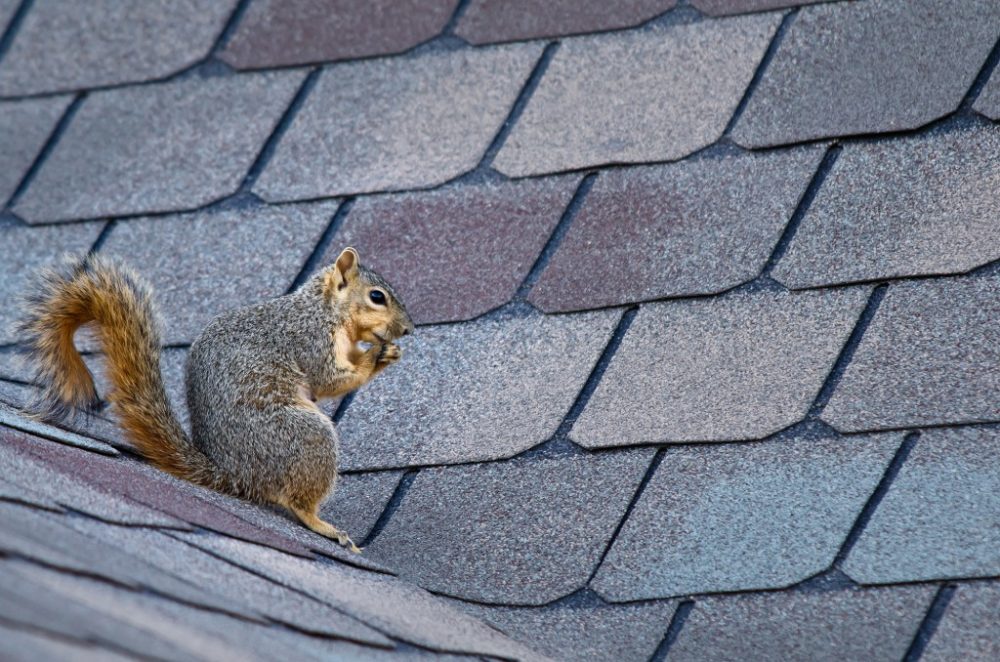
Termites:
Acting quickly is the first step to reliable termite control; because the longer you wait, the harder it will be to remove termites from your home environment. Controlling these troublesome termites is crucial because not only do they carry diseases and transport bacteria that pose health risks; they also destroy your house one bite at a time!
Termites eat material that contains cellulose, such as wood, roots, plant debris, paper, or cardboard. Termites can gain entrance into a structure through any part of the wood frame in contact with the ground, through openings in the foundation around pipes and conduits, or through cracks in the foundation. Termites can enter through cracks that are no wider than 1/64 of an inch.
Subterranean termites need moisture to survive. They will create mud tubes to obtain access to a structure that is above ground. These tubes are created from soil cemented with secretions and fecal material. The tubes are to protect the termites from exposure to sunlight or dry conditions. Termites can survive in a structure without contact with the ground if there is a sufficient moisture source.
Workers are one-fourth inch long, light-colored, and wingless. Soldiers have elongated heads with mandibles. Supplementary reproductive individuals are light-colored and wingless or have very short, nonfunctional wings.
Termites cause over $2 billion in damage each year in North America. Subterranean termites cause 95% of all termite damage. Colonies can contain up to one million members.
Here is how you can protect your home?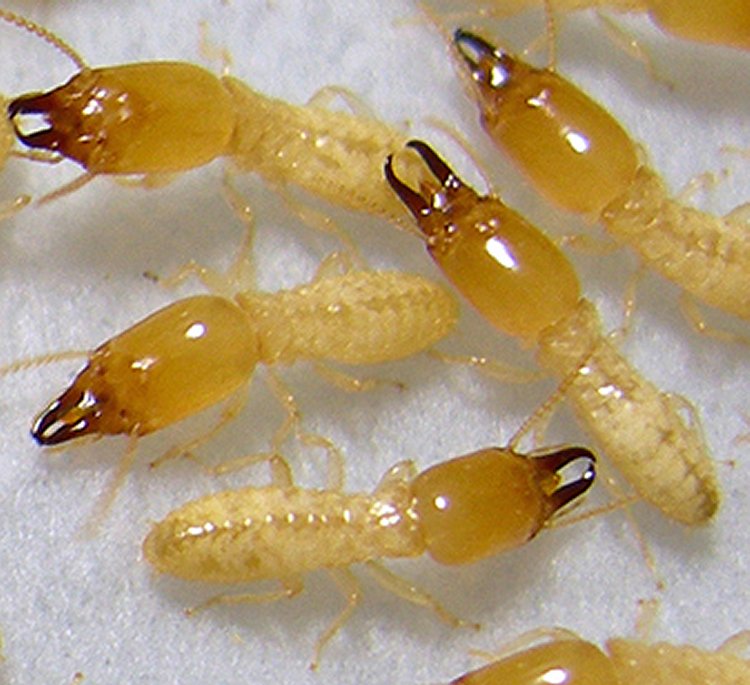
- Start by eliminating food and moisture conditions around your home
- Repair leaking faucets, water pipes, and a/c units
- Divert water from the foundation
- Keep gutters and downspouts clean
- Ventilate crawl spaces
- Remove excessive plant cover and wood mulch
- Get rid of standing water on the roof
- Keep all vents clear and open
- Seal entry points around water and utility lines or pipes
- Keep firewood, lumber, or paper away from foundation or crawl spaces
- Get rid of stumps and debris near the house
- Wood on your home shouldn't contact the soil
What we will be checking for when we inspect your home for termite:
- A temporary swarm of winged insects in your home
- Any cracked or bubbling paint
- Wood that sounds hollow when tapped
- Mud tubes on exterior walls, wooden beams, or in crawl spaces
- Discarded wings from swarms
House Mouse:
Mice usually walk, run, or stand on all fours. But when eating, fighting, or orienting themselves, they stand only on their hind legs supported by the tail. When running, the horizontal tail serves for balance. Mice are good jumpers, climbers, and swimmers.
Mice are mostly active during dusk or at night. They do not like bright lights. They live in a wide variety of hidden places that are near food sources or sewer openings and construct nests from various soft materials. Usually, most home invasions occur in the fall due to cooler weather and because the seeds and plants on which they feed outside are gone.
Mice need extraordinarily little food and area to live. For some homes, mouse control is an annual event. So never think the war is over. House mice often make homes in large electrical appliances, and here they may chew up the wiring as well as insulation, resulting in short circuits that create fire hazards or other malfunctions that are expensive to repair. Make sure your battery-operated smoke detectors work. So, if there is a fire, you can get out.
Mice may also damage stored items in your attics, basements, or garage. Damaged family heirlooms, paintings, books, documents, and other such items may be impossible to replace.
Litters of 5 or 6 young are born 19 to 21 days after mating. Newborn mice are naked, and their eyes are closed. They grow rapidly and after 2 weeks they are covered with hair and their eyes and ears are open. Mouse populations can therefore grow rapidly under good conditions. They begin to make short excursions from the nest and eat solid food at 3 weeks. Weaning soon follows, and mice are sexually mature as early as 6 to 10 weeks old.
Among the diseases mice or their parasites may transmit to humans are salmonellosis (food poisoning), rickettsial pox, and lymphocytic choriomeningitis. Mice may also carry leptospirosis, rat-bite fever, tapeworms, and organisms that can cause ringworm (a skin disease) in humans. They have also been found to act as reservoirs or transmitters of diseases of veterinary importance, such as swine dysentery, a serious bacterial disease of swine often called "bloody scours."
How the disease spreads: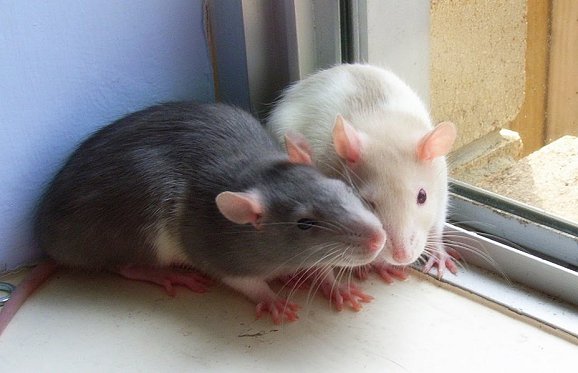
- Breathing in dust that is contaminated with mouse/rat urine or droppings
- Direct contact with mouse/rat or their urine and droppings
- Bite wounds, although this does not happen frequently
- Eating or drinking food or water that is contaminated by mouse/rat feces
Cockroach :
German cockroaches are the most common and prolific household insect found in the United States. The pest is usually found infesting the kitchen or bathroom but has the ability to live in any portion of any heated structure. They are usually found in dark, secluded harborage areas such as cupboards, behind cabinets, in wall voids, or around motor housings in appliances.
Cockroaches can enter your home in many different ways, from the outside through cracks and crevices to grocery bags and on yourself! With plenty of food, warmth, water, and nesting sites, your home is an ideal breeding ground for most species of cockroaches.
The dust created by cast-off cockroach skins, dead bodies, and droppings can aggravate allergies and asthma, especially in children and sensitive individuals.
The adult female produces four to eight light brown egg capsules in her lifetime. Each capsule is about 1/4-inch 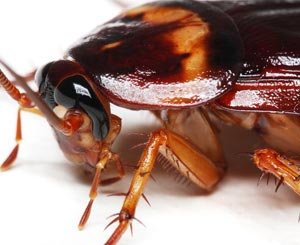 long and contains 30 to 40 eggs. The female carries the egg capsule partially within her abdomen until just before the nymphs are ready to emerge. If the egg capsule is dropped prematurely the developing roaches will die of dehydration. The nymphs emerge from the egg capsule in 28 to 30 days and they feed and live in the same areas as the adults. The nymphs will molt six to seven times before becoming adults. There are three to four generations per year with each generation averaging three months. With ample food and moisture, one female can produce over a million descendants in a year. German cockroaches feed on all types of food, wood, soap, and just about anything else with the nutritive value found in a home.
long and contains 30 to 40 eggs. The female carries the egg capsule partially within her abdomen until just before the nymphs are ready to emerge. If the egg capsule is dropped prematurely the developing roaches will die of dehydration. The nymphs emerge from the egg capsule in 28 to 30 days and they feed and live in the same areas as the adults. The nymphs will molt six to seven times before becoming adults. There are three to four generations per year with each generation averaging three months. With ample food and moisture, one female can produce over a million descendants in a year. German cockroaches feed on all types of food, wood, soap, and just about anything else with the nutritive value found in a home.
German cockroaches remain hidden in dark, secluded harborage areas in the day. They and their egg capsules can be brought into homes in boxes, cartons, grocery and produce bags, household items, and children's book bags from school. German cockroaches carry disease organisms on their bodies which can be transferred from garbage, filth, and decaying organic matter to food, dishes, and kitchen utensils. Contamination results from spots of regurgitated food and fecal matter on household items. IF THEY ARE SEEN DURING DAYLIGHT, IT IS A SURE SIGN THAT A TREMENDOUS POPULATION EXISTS. German cockroaches like to congregate together in their harborages, but if the population becomes too large, they will be forced to move out of the safest areas for new places to start another infestation.
Sanitation is the cornerstone of effective, long-lasting German cockroach control. Light infestations are common in homes although heavy, continuing infestations are usually associated with sloppy housekeeping. Food material must be eliminated as much as possible and harborage areas sealed where possible. Residual insecticides, dust, baits, and growth regulators are necessary to control existing populations and to prevent their recurrence.
Cockroach disease is something that many people are worried about when they see a cockroach in their home. Cockroaches are known to carry diseases because they can live on about anything, meaning they often live on unsanitary substances. When you look at the cockroach anatomy you might only get creepy-crawly sensations, but chances are there is a lot more there than that.
Cockroach disease can affect humans. Cockroaches are known to carry diseases like dysentery, typhoid, and poliomyelitis, as well as gastroenteritis. Cockroaches can live about anywhere and can live on fermenting products, septic dressings, hair, leather, wallpaper, feces, rotting food, and more. Because many of the products that cockroaches feed on are spoiled or simply unsanitary, it's easy to see where cockroach disease comes from. Many of the substances that they feed on are already contaminated, and as the cockroach moves from one location to another it spreads the disease along the way.
Not only can people get sick from the diseases that cockroaches contaminate human living space with, but many humans are also allergic to cockroach feces. Of course, no one exposes themselves to cockroach disease and feces on purpose, but it can happen by inhaling particles of dust in the air that has been left behind by the cockroach. Food can also be contaminated with the smell of cockroaches, which is very distinct. Food can have particles of feces, salivary gland secretions, as well as dead insects if it has not been stored properly. If people eat food that has not been properly stored, they can be exposed to all these things, which can cause asthma as well as other health conditions in those that are sensitive.
Cockroach disease is nothing to fool around with. Even if you just don't like bugs, you must consider the disease and filth that these insects bring into your home. Cockroach control is very important because you cannot always see, smell, or even taste the presence of cockroaches, yet you can ingest these items and become sick.
Cockroaches can cause 2 potentially serious health problems. First, they may provoke allergic reactions. Second, they have been suggested as vectors of multi-drug-resistant pathogens. Cockroaches that live and breed in hospitals have higher bacterial loads than cockroaches in houses.
Fire Ants :
The fire ant (red imported fire ant, Solenopsis Invicta Buren), is an invasive insect whose sting can cause serious problems. Where imported fire ants are common, most homeowners recognize them by the mounds they build or the stings they inflict. However, there are also other characteristics to look for. Their aggressive nature compared to other ant species is one such trait. If a mound is disturbed, usually hundreds of fire ant workers will swarm out and run up vertical surfaces to sting. These ants are social insects and unlike many insect pests, they are very organized. Fire ants are aggressive and will defensively attack anything that disturbs them. Fire ants can sting repeatedly. Symptoms of a fire ant sting include burning, itching, and a white, fluid-filled pustule that forms a day or two afterward.
Colonies consist of the brood and several types (castes) of adults. The whitish objects often found at the top of the mounds are the ant's developmental stages or brood- the eggs, larvae, and pupae.
Imported fire ants interfere with outdoor activities and 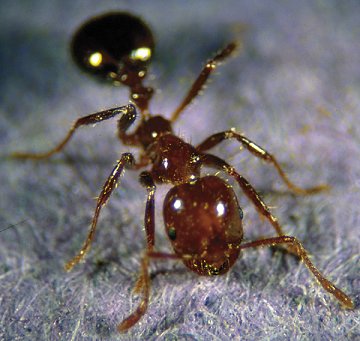 harm wildlife throughout the southern United States and elsewhere. Fire ants form colonies close to homes and other buildings sometimes forage indoors for food and moisture, particularly during the hot, dry, summer months. Entire colonies occasionally nest in wall voids or rafters, or behind large appliances, sometimes moving into buildings during floods or drought. They are a nuisance and can threaten sleeping or invalid people and pets. Fire ants frequently infest electrical equipment. They chew on insulation, can cause short circuits, and can interfere with switching mechanisms. Air conditioners, traffic signal boxes, and other devices all can be damaged. Fire ants also nest in the metal housings that surround electrical and utility equipment. They frequently move soil into these units, which can cause corrosion, electrical short circuits, and other mechanical problems. Ants occasionally feed on vegetable plants in home gardens. They tunnel into potatoes underground and feed on okra buds and developing pods. The worst damage usually occurs during hot, dry weather. Ants may be a nuisance to gardeners during weeding and harvesting.
harm wildlife throughout the southern United States and elsewhere. Fire ants form colonies close to homes and other buildings sometimes forage indoors for food and moisture, particularly during the hot, dry, summer months. Entire colonies occasionally nest in wall voids or rafters, or behind large appliances, sometimes moving into buildings during floods or drought. They are a nuisance and can threaten sleeping or invalid people and pets. Fire ants frequently infest electrical equipment. They chew on insulation, can cause short circuits, and can interfere with switching mechanisms. Air conditioners, traffic signal boxes, and other devices all can be damaged. Fire ants also nest in the metal housings that surround electrical and utility equipment. They frequently move soil into these units, which can cause corrosion, electrical short circuits, and other mechanical problems. Ants occasionally feed on vegetable plants in home gardens. They tunnel into potatoes underground and feed on okra buds and developing pods. The worst damage usually occurs during hot, dry weather. Ants may be a nuisance to gardeners during weeding and harvesting.
Although fire ants do prey on flea larvae, chinch bugs, cockroach eggs, ticks, and other pests, the problems they cause usually outweigh any benefits in urban areas.
Properly identifying an ant species is the first step in determining whether the ants should be managed and how to do so. While it may not be possible to eradicate fire ants, controlling them is highly desirable. The best control programs use a combination of non-chemical and chemical methods that are effective, economical, and least toxic. Most management options require repeated treatments to maintain control. If you treat and your neighbor does not, you will find your yard is quickly re-infested. If you educate your neighbors, you can coordinate your battle against the imported fire ant more effectively and efficiently.
Many home remedies have been tried and while these methods sometimes appear to work, they rarely eliminate colonies. Disturbing (or knocking down) mounds frequently will cause colonies to move. Some people believe shoveling one mound on top of another will force ants to kill each other, but this is not true. Sprinkling grits or other solid food substances onto fire ant mounds is ineffective. It has been suggested that when the ants eat the grits their stomachs will swell and rupture. In fact, only the last larval stage of the developing fire ant is known to digest solid food. All other life stages feed only on liquids or greasy materials. Gasoline and other petroleum products do kill some fire ant colonies. However, petroleum products are dangerously flammable or explosive, kill grass and plants around the treated mounds, and can seriously pollute the soil and groundwater. Using petroleum products, solvents, battery acids, bleach, or ammonia products can be dangerous and is strongly discouraged. Pouring extremely hot or boiling water on a mound is an effective treatment, particularly when ants are close to the mound surface such as on a cool, sunny morning or after heavy rainfall. Approximately 3 gallons of extremely hot (almost boiling) water poured on each mound will eliminate about 60 percent of the mounds treated. Be careful handling large volumes of hot water to prevent serious burns and keep hot water off desired plants and grass. Individual mounds can be carefully shoveled into a bucket dusted on the inside with baby (talcum) powder and the ants drowned with soapy water, but this rarely eliminates all ant colonies in the area.
Fleas:
Adult fleas are parasites of warm-blooded animals such as cats, dogs, and humans. Fleas go through complete metamorphosis, meaning they have an egg, a larva, a pupa, and an adult stage. Under most situations, fleas will complete their life cycle within three to five weeks.
The female flea will lay 4 to 6 eggs after each blood meal  and can usually lay several hundred during her lifetime. The light-colored eggs are deposited while on the host, but they fall off the animal and are frequently found in the host's bedding, carpets, sofas, and crevices on the floor. The eggs normally hatch between 1 and 10 days, depending on temperature and humidity, while most hatch within 36 hours.
and can usually lay several hundred during her lifetime. The light-colored eggs are deposited while on the host, but they fall off the animal and are frequently found in the host's bedding, carpets, sofas, and crevices on the floor. The eggs normally hatch between 1 and 10 days, depending on temperature and humidity, while most hatch within 36 hours.
Flea larvae are slender, white, legless and between 1/10 and 1/5 inch long. They are free-living and feed on debris found in their environment. The larval stage usually lasts between 5 and 11 days but can be extended up to 3 weeks if conditions are not favorable. Flea larvae are overly sensitive to heat and desiccation (drying out), and therefore thrive in shaded, protected areas.
Most adults will emerge from the pupa stage in 5 to 10 days. If a host is not present, the flea can remain in the pupa stage for up to 140 days. Emergence from the pupa stage is triggered by the host's body heat, movement, and exhaled carbon dioxide. This stage is the most resistant to pesticides and desiccation.
Fleas are extremely adaptable insects and flea populations can exist inside homes for extended periods of time without a host animal.
Successful flea control
1. Pets must be treated. This should be done either prior to application or on the same day the house and lawn are treated.
2. The house and lawn must be properly prepared and treated. The homeowner must properly prepare the home for chemical treatment by:
- Thoroughly vacuuming all floors and upholstered furniture (don't forget closets, under cushions, and the pet's favorite resting places). The vacuum cleaner bag must be disposed of immediately because it can harbor flea eggs and larvae.
- Thoroughly wash or dispose of pet bedding.
- All floors should be cleared of items that may interfere with treatment.
- All pets, including birds, should be removed from the home during treatment. Fishbowls and aquariums can remain in the house if they are covered, and the filtering system is turned off.
Once the home is properly prepared, a licensed technician can apply a residual insecticide as well as a growth inhibitor to areas such as flooring, cracks and crevices, upholstered furniture, and animal sleeping areas. You will be instructed to leave your home for 3 to 4 hours following the application of the insecticide.
3. The lawn is treated. Outdoors flea control consists of an application of a residual insecticide over the affected areas of the lawn, shrubs, patios, and walkways as well as other areas, as needed.
Insecticides only affect the larva and adult stages, so the insecticide must be left undisturbed until the fleas reach one of these stages of their life cycle. You will notice flea activity after treatment because this insecticide has a delayed effect on emerging fleas. THIS DOES NOT MEAN THE INSECTICIDE ISN'T WORKING! It may take up to three weeks before all activity ceases.
Homeowners often return home after several days following treatment and are shocked to be attacked by fleas. Remember, flea pupae are unique so that insecticides cannot control the fleas when protected by the pupa casing. The chemical will control these emerging fleas over several days if they are stimulated to emerge from the pupal casing.
Your complete understanding of flea life cycles and total cooperation with professional licensed exterminators are essential for successful flea control.
Notes:
- Fleas are transported into an area by animals such as squirrels, raccoons, cats, dogs, opossums, and even humans; or by packages delivered from an infested warehouse. When there is no residual insecticide left, a new infestation can begin.
- Keep pets off freshly treated surfaces, including the lawn, until they are dry (usually 2-4 hours).
- Let the treatment dry before you reenter the home (usually 2-4 hours).
Please call us at 360-706-9097 or contact us by e-mail if you have any questions or comments or make an appointment by clicking on the button below for a free estimate on all work that you may want to be done. We are available 6 days a week (Mon.-Sat.) between 10 a.m. to 7 p.m.
